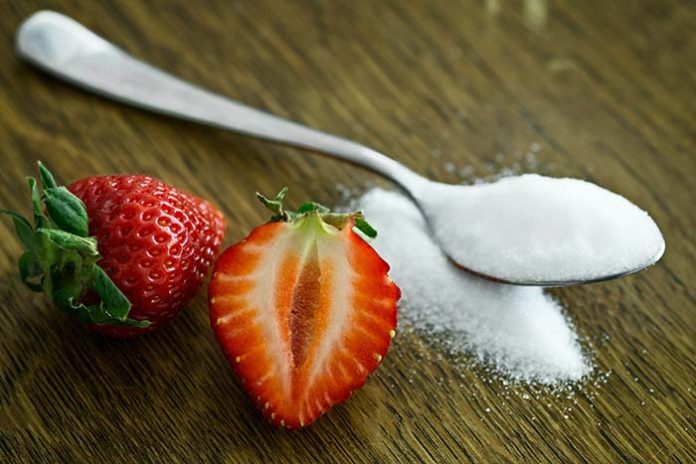Crystalline fructose is a naturally occurring sugar used as a nutritive sweetener, flavoring, and additive for food and beverages.
Due to its low glycemic index and enhanced sweetness, it offers advantages like blood sugar control and calorie reduction. Due to these reasons, crystalline fructose has been making rounds for its use in diabetic food or low-calorie diets.
But wait, there’s more! This article will explore its various uses in food and drinks. We’ll also dive into the nitty-gritty, discussing potential side effects you should be aware of. Let’s have a look at the so-called ‘diabetic-friendly carbohydrate’!
What Is Crystalline Fructose?
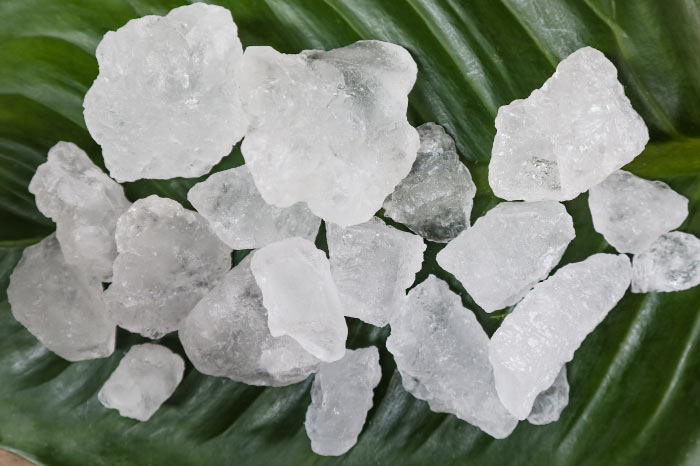
Crystalline fructose is a type of natural sugar with a fructose content of 98%. Compared with table sugar, the latter contains 50% fructose and 50% of glucose. While the crystalline fructose is chemically similar to glucose, it differs in structure and how our body processes it (will get to that later).
Fructose is a sweet, white, odorless, water-soluble, crystalline solid. Naturally, it is found in honey, fruits, and vegetables, while commercially, it is made from corn and sugarcane.
Crystalline fructose is used as a sweetener in various products, from soft drinks to baked goods. It is sweeter than sucrose, so a low quantity achieves the same sweetness. Besides, it does not cause a rapid glucose surge in the blood. That’s why it is a popular choice for sugar among manufacturers and consumers alike.
| Other Names | Fruit sugar, D-fructose, fructose monohydrate |
| Appearance | White, odorless, crystalline solid |
| Chemical Formula | C6H12O6 |
| Molecular Weight | 180.16 g/mol |
| Source | Fruits, vegetables, honey, corn, and other vegetables |
| Glycemic Index | 19 |
| Sweetness Scale | 1.2-1.8 times sweeter than sucrose |
Crystalline Fructose Vs. Sucrose (Table Sugar)
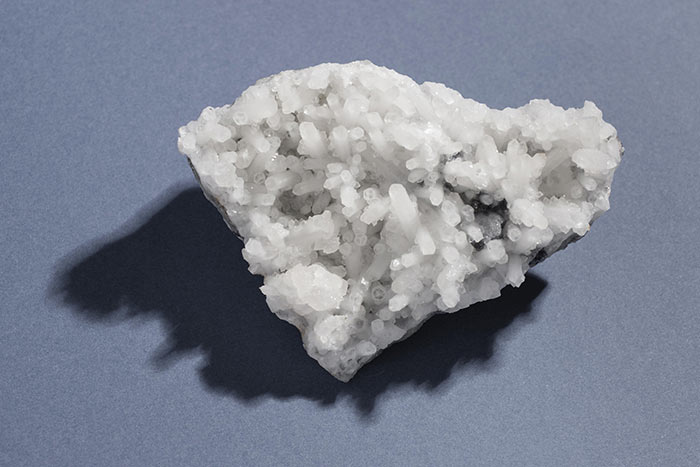
Crystalline fructose and table sugar (sucrose) both may sweeten your day, but they’ve got distinct differences. Sucrose is a disaccharide comprising both fructose and glucose in a 1:1 ratio, while crystalline fructose contains pure fructose.
It packs a sweeter punch, about 1.2 to 1.8 times sweeter than table sugar. So, it imparts the same level of sweetness in less quantity. This way, you consume fewer calories. And if you are trying to lose belly fat, what’s better than a calorie cutdown? Moreover, it has a clean and intense sweetness with a lasting aftertaste.
Crystalline fructose has a lower glycemic index, i.e., 19, than sucrose, which has a glycemic index of 65. The glycemic index of a carbohydrate tells you about how it affects your blood glucose levels.
It means fructose does not cause a rapid rise and fall in blood glucose levels, making it a good choice for people with diabetes and glucose metabolism dysfunction.
This low glycemic index is because of the difference in the metabolism of both sugars. Fructose is primarily metabolized in the liver and does not require insulin for its absorption. So it does not impact blood glucose levels as rapidly as sucrose.
Advantages Of Crystalline Fructose
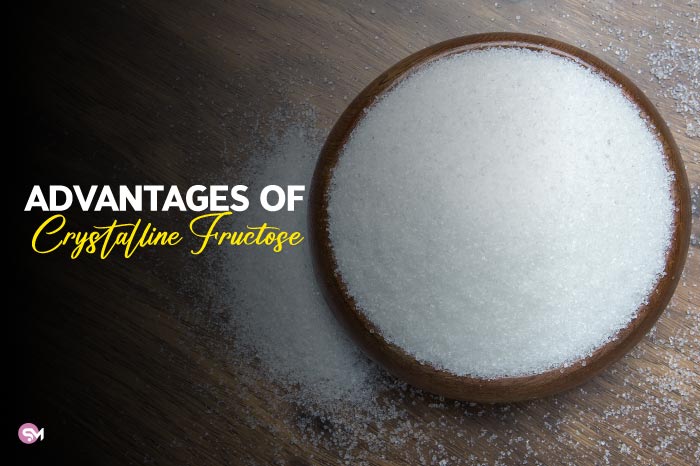
Crystalline fructose boasts several advantages, making it an excellent alternative to sucrose.
Low Glycemic Index
Crystalline fructose has a low glycemic index of 19. It means it does not increase blood sugar rapidly. Instead, it releases glucose slowly, keeping you full for longer and your blood sugar in check.
Fructose doesn’t cause Tooth Decay
Unlike sucrose, crystalline fructose is less likely to cause tooth decay as it is not fermented by oral bacteria. It does not impact oral health, making it a dental-friendly sweetener.
Fructose Reduces Calorie Consumption on Intake
Crystalline fructose is sweeter than sugar, requiring less quantity to achieve the same level of sweetness. It reduces overall calorie intake in foods and beverages and helps manage body weight.
Pro tip: include low-fructose fruits in your diet if you are trying to lose weight, such as oranges, lime, pineapples, and watermelon. They not only give perfect flavor and sweetness, offer multiple antioxidants and vitamins, keep the calorie count minimal, but also help to reset your metabolism.
Fructose is Natural Food Preservatives
Crystalline fructose has hygroscopic properties, reducing water activity in the products. Reduced water activity discourages microbial growth and spoilage, making fructose an excellent natural preservative.
Fructose can Enhance Flavor
Crystalline fructose can enhance the taste and flavor profile of many foods and beverages. Combining it in a 1:2 ratio with sucrose results in high flavor intensity and profile of sports drinks. It is also used to mask the aftertaste of other high-potency sweeteners.
Uses Of Crystalline Fructose
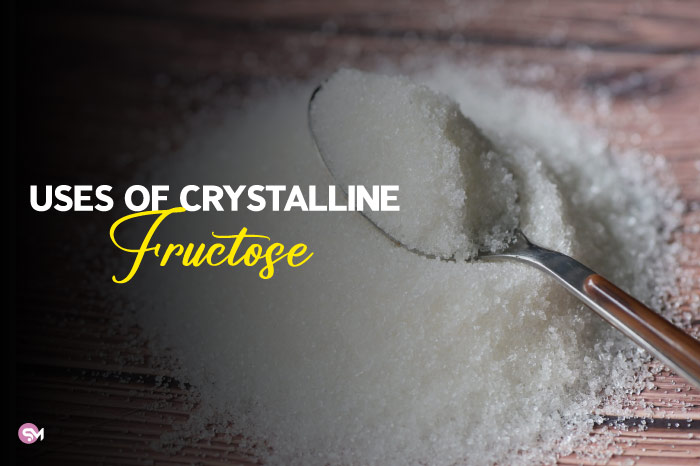
Crystalline fructose finds its way into various culinary creations and dietary applications thanks to its unique properties. Let’s have a look at the most essential uses of crystalline fructose.
Used as Sweetener for Baked Goods
Crystalline fructose is used as a sweetener for baked goods, like bread, muffins, or cookies. It keeps the products soft and fresh through its water retention properties.
Moreover, fructose provides an attractive browning and aroma to the baked goods. Fructose is difficult to recrystallize once it is solubilized; it results in soft, moist cookies.
Used in Diabetic Friendly Diets
Due to its low glycemic index, crystalline fructose releases glucose slowly into the blood after consumption. That’s why it is preferred in diabetic-friendly diets to manage glucose levels effectively.
Used in Frozen Desserts Like Ice-Creams
In frozen desserts, like ice creams and sorbets, crystalline fructose not only provides sweetness but also maintains a smooth texture by reducing ice crystal formation. It makes for a softer, creamier, and more enjoyable frozen treat.
Used as a replacement for Sugar in Drinks And Beverages
Crystalline fructose is often used as a replacement for table sugar in various drinks and beverages. Its low glycemic index and flavor-enhancing ability make it a better choice for sports drinks, flavored water, or dry mix drinks.
Is Crystalline Fructose Bad For You? Potential Side Effects

Sucrose and High Fructose Corn Syrup (HFCS)- which fructose is a major component of- are Generally recognized as safe (GRAS) by the FDA. So, the safety profile of pure crystalline fructose is well-known in typical quantities (80-90 grams per day). However, a high intake of fructose is said to be responsible for several health problems.
Excess of Fructose intake Damage Liver Functions
Since fructose is metabolized in the liver, it is converted into triglycerides, a form of fat. Increased fat accumulation due to high fructose intake promotes non-alcoholic fatty liver disease, damaging liver functions.
Can Cause Weight Gain
Using high amounts of fructose, especially as an added sugar, is usually associated with weight gain and obesity. The American Heart Association recommends a maximum of 5 teaspoons of added sugar for women and 9 teaspoons for men.
Cause Heart Diseases
Increased consumption of crystalline fructose may also lead to an increase in cholesterol, blood pressure, and heart diseases.
Also Read: Low Cholesterol Diet Plan
Increased Risk Of Gout And Kidney Stones
Fructose is partly converted into uric acid in the liver, which can contribute to developing gout and kidney stones.
Metabolic Disorders
Metabolic disorders, like insulin resistance, dyslipidemia, and metabolic syndrome, are some of the consequences of overeating fructose as an added sugar.
Note: all these harmful effects of fructose occur when fructose is used as an added sugar. The natural sugar found in whole fruits is in low quantity and does not pose a danger unless eaten in excessively high amounts, which is unlikely with fruits.
Final Verdict!
The verdict on crystalline fructose is clear: it can be a valuable addition to your diet when used sensibly, enhancing the sweetness of your favorite treats while keeping your health in check.
However, balance and moderation remain the guiding principles for making the most of this sweet alternative. When used excessively as an added sugar, the damage caused by it can overpower the sweetness.


